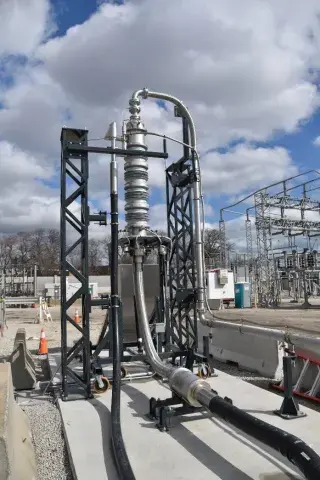In early September, Hurricane Ida caused a massive blackout, leaving New Orleans in the dark for more than two days. A month before Ida, Tropical Storm Henri cut power to 100,000 households in Rhode Island. The wildfires in the western United States are common sources of blackouts in California. And earlier this year in Central Texas, harsh winter conditions led to a breakdown of the state’s electric grid, leaving one million people without heat and electricity for days.
These types of events are increasing in frequency as the nation’s infrastructure ages and climate change leads to extreme weather events. Hotter, wetter summers and harsher winters require more reliance on heating and cooling utilities, placing higher stress on the nation’s electric grid. For nearly a decade and a half, the Science and Technology Directorate (S&T) has teamed up with industry and one of the nation’s largest (and windiest) cities to study how technology can ‘help keep the lights on’ during emergencies. This fall, S&T and its partners announced the fruits of this labor: the successful installation and operation of the Resilient Electric Grid (REG) system in Chicago.
How the Electric Grid Works
The electric grid is a complex network that spans the creation of electricity at a power generation station to the delivery of electricity to the end user. To get from the generation site to the end user, often several (possibly hundreds of) miles away, electricity travels through the transmission system, which converts the very high voltage electricity generated by the power plant to lower voltages. The electricity is further stepped down in voltage through the distribution network as it gets closer to homes, business, and other facilities. Major urban communities have multiple distribution level substations throughout the city to meet the electrical power needs of its population.

Ideally, these distribution substations would be interconnected, so if one substation fails for any reason, another can step in and provide electricity—like driving on system of highways, streets, and roads where you have multiple routes that can get you to the same destination. In reality, however, distribution substations are not interconnected. This is a designed safety feature in the grid so that an issue at one substation, such as a fault current (a large spike in electric current) doesn’t cascade down through the system and impact other substations.
As a result of this set up, if a substation fails, the area that that substation serves experiences a blackout. But what if we could prevent the risk associated with connecting substations so that in the event of a substation failure, other substations could step in and “help” continue to deliver power, creating multiple paths for power to flow just like how traffic flows on the internet?
S&T Powered (and Empowered) a Solution
Finding a solution to increase grid resilience inspired S&T to launch its REG project back in 2007. The project built on the Department of Energy’s (DOE) previous research on High Temperature Superconducting (HTS) cables.
S&T’s Sarah Mahmood, an electrical engineer, led the S&T project team in collaboration with American Superconductor (AMSC), a leading system provider of megawatt-scale power resiliency solutions.
Together, the team developed REG systems featuring cable systems that utilize AMSC’s proprietary Amperium® HTS technology designed to suppress surges while providing the ability to connect substations without risking a cascading fault current.
“Substations are usually not connected because of the risk of fault currents. It’s like a surge. In your house, you use a surge protector. If you don’t have protection against fault currents, you risk damaging the equipment downstream. But because they’re not connected, they lack resiliency,” Mahmood explained.

How a Superconductor Works
HTS cables use liquid nitrogen to keep the cable cool enough to function in a superconducting state. If the HTS cable experiences a fault, the fault creates energy which heats up the system so that it is no longer in a superconducting state, essentially turning itself off automatically, like a switch, preventing equipment damage. What’s more, because HTS cables are superconducting there is very little resistance or loss of power over the length of the cable making them more efficient compared to traditional power cables which experience a loss of power over distance.
After years of research, development and lab testing to prove the concept of a fault current limiting high temperature superconducting cable, S&T and AMSC partnered with Commonwealth Edison (ComEd), the largest electric utility in Illinois serving over four-million customers, to integrate the technology in the grid.

“S&T is grateful for the partnership with ComEd enabling us to install the REG system in the grid as a permanent asset, hopefully setting a pathway for broader market adoption of this new capability by industry as a potential solution to increase grid resilience,” Mahmood explained.
“The successful integration of the REG system is a major milestone in our efforts to enhance our service to customers through innovation,” said Terence R. Donnelly, President and COO of ComEd. “The increasingly frequent and severe weather events associated with climate change and the need for enhanced cyber and physical security require grid investments that will sustain the high levels of safe and reliable power that our customers depend on.”
HTS Technology Brings Resiliency to Power Grid Operations
A stable homeland is dependent on the reliable delivery of electricity—from public health to the economy and national security. According to DOE's Grid Modernization and the Smart Grid project, there are more than 9,200 electric generating units with more than 1 million megawatts of generating capacity feeding more than 600,000 miles of transmission lines that comprise the U.S. electric grid.
“Our superconductor-based REG system improved the reliability and resiliency of the grid, reducing disruption to public infrastructure and saving money for utility customers—all in an environmentally-friendly manner,” said Daniel P. McGahn, Chairman, President & CEO, AMSC. “We believe this accomplishment opens opportunities for AMSC to deploy REG systems to other innovative utilities.”
On September 30, DHS and DOE participated in a ribbon-cutting in Chicago to highlight the REG system installation into the ComEd grid. ComEd is the first utility in the United States to permanently install the AMSC REG system into the grid and will evaluate connecting it to multiple substations in order to create a back-up system for continuous power delivery even with a disruption to the power grid.

“S&T will continue to monitor the REG system’s performance with hopes for future commercialization, as other utilities look to increase grid resiliency,” said Mahmood.
According to a According to a DOE study (PDF, 28 pgs., 725KB), the United States loses nearly $70 billion each year from power outages. S&T’s continued research and development efforts aim to enhance the nation’s overall energy resilience, so future generations can keep the lights on.
For related media requests, contact STMedia@hq.dhs.gov
